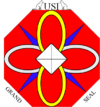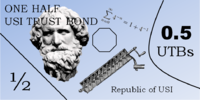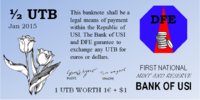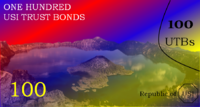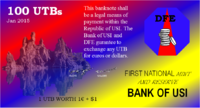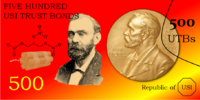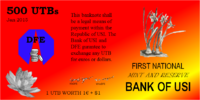Usian Republic
This article refers to a nation which is currently in a state of inactivity. You can help make the article reflect that or ask on the talk page for further information. |
Usian Republic | |
|---|---|
| Motto: Justitia et Aequalet (English: Justice and equality) | |
| Anthem: Temporary Anthem (largely excerpt from The Nutcracker) | |
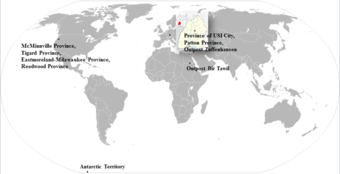 Central Europe, Western North America, Bir Tawil, Antarctica | |
| Capital | Usipolis |
| Largest city | Patton |
| Official languages | English, German |
| Demonym(s) | Usian |
| Government | Semi-presidential/presidential republic (unique) |
| Legislature | Usian Parliament |
| Establishment | 13 July 2014 |
| Population | |
• (As of 1 November 2024; only citizens counted) census | 33 |
| Currency | Reni (r) |
| Time zone | UTC+1, UTC+9 |
Website Official government website | |
This nation is a member state of the Nollandish Confederacy. | |
The Usian Republic[1] [IPA: /uːsiː/, /ʊziː/ or /uːziː/] (formerly the Republic of USI or also just USI, alternatively Usi)[2] is a secessionist micronation founded on 13 July 2014. It is a democratic republic territorially split into ten enclaves.[3] As of 1 November 2024, it has thirty-three citizens.[4]
Usi is culturally far developed. Its flag of irregular proportions has four colors and may optionally bear the nation's grand seal in the upper left corner.[3] The nation's seal functions as its coat of arms.
The majority of citizens are liberal, and the vast majority identifies as economically center-left. The currently governing party strives to achieve a market socialist economy and to expand social programs.[3]
Though the nation used to exist by the names of Usian Republic as well as Republic of USI, in recent times, Usian Republic has become more popular, as it avoids the awkward capitalization that leads many to believe it is an acronym; the capitalization ("USI") is an outdated cultural quirk.[1]
The Usian Republic is still in a transitional phase of its development and thus, to a certain extent, unstable.
Etymology and pronunciation
The name Usi has no meaning and thus no etymology; evidently counter-intuitively (there have allegedly been at least two false associations), it neither has any connection to the machine gun of a somewhat similar name when pronounced /uːziː/, nor is it an acronym. The word was first used in German, which is the reason for the odd pronunciation. The use of capital letters is an unexplained cultural quirk and is optional. Usi is usually pronounced /uːsiː/, less commonly /ʊziː/ or /uːziː/ (see International Phonetic Alphabet); Its demonym, Usian, is pronounced /uːʒiːæn/. Note that Usian is also defined as "of, relating or pertaining to any aspect of Usi".[2]
History
The Usian Republic was officially proclaimed an independent nation on 13 July 2014,[2] in its Constitution.[5] The earliest beginnings of Usi as a country- or city-like entity were in 2008, it being planned unrealistically as a glass platform raised two kilometers off the ground and being mostly for economic purposes. It had existed in a more earth-based and nation-like way since 2011, claiming a large portion of Australia, as "Usi-Land", and with only one citizen. Only on 12 July 2014 did the "government" become aware that there was such a thing as a micronation, and promptly took measures to officially become one, which included drastically altering territorial claims. Much was taken for the Republic from the defunct Usi-Land, including the flag and seal, some parts of the government, a city by the name Usi City as the capital (which was, on 20 April 2015, renamed to Usipolis), and, of course, the name Usi itself. See Timeline of Usian history.
State of Emergency
The Usian Republic declared a legislative State of Emergency on 3 November 2014, as the solution to the inactivity of the Parliament. This was largely due to the Parliament's being too large to make any informed decisions regarding new laws. Thus, a unicameral Emergency Parliament of eight seats, inferior to the Parliament, was formed. The State of Emergency officially began on 5 November 2014 and was lifted on 15 June 2015, with the conclusion of parliamentary elections.[1]
External classification
There are five major classification systems used by some to rate the development and quality of a micronation. The first calculation, on 25 August 2014, resulted in Usi being classified as a "5th world" micronation on the Boodlesmythe-Tallini scale; rated a '3.2' in Dresner's System (Considered "a very average micronation"). The Usian Republic scored badly on the categories "Allies" and "Sphere of influence" because it was then a very young micronation).
Matthew's Democracy System of classification, concerned solely with the level of democracy of the government, calls the Republic a "fair democracy" (4.0).
As its economy was, and still is, extremely small, it did not score well by Miles's System of Economic Classification.
On 1 September 2014, the government decided to recalculate at least three of the classifications on a monthly basis, or when there was a major change. Owing to it being overlooked before, the National Statistics Office (NSO) added Linden's Revised System to the calculations on 12 September 2014, the Usian Republic "most surprisingly, but in a pleasant way", as an NSO speaker said that day,[1] scoring a 4.4 on the scale ("One of the most significant micronations [...]". As the Republic has been perceived as a "very average micronation" because of the Dresner rating and never been thought of as "one of the most significant micronations" by its citizens and the government, the scale has been subject to skepticism.
The very next day, the NSO also added Stü'òrd's System of Micronational Classification, and promptly calculated a probably more accurate '3.4'.
The Usian Republic is an "organization" by the Milic definition of statehood.
| Date | Boodlesmyhte-Tallini | Dresner | Matthew | Linden |
|---|---|---|---|---|
| 1 April | No change | Same | Same | Same |
| 1 March | 5th-world (10.) | 4.2 | 4.8 | 4.6 |
| 1 February | 5th-world (10.) | 4.2 | 4.3 | 4.6 |
| 1 January | 5th-world (10.) | 3.8 | 4.3 | ? |
| Date | Boodlesmyhte-Tallini | Dresner | Matthew | Linden | Stü'òrd |
|---|---|---|---|---|---|
| 1 December | 5th-world | 4.0 | 4.0 | 4.4 | ? |
| 1 November | 5th-world | 4.0 | 4.0 | 4.4 | ? |
| 12–13 September | 5th-world | 3.6 | 4.0 | 4.4 | 3.4 |
| 1 September | 5th-world | 3.6 | 4.0 | ||
| 25 August | 5th-world | 3.2 | 4.0 |
Government


The current government of Usi is a simplified version of the government that is to supersede it should the number of citizens grow to about the population of a small town. It follows the traditional system of separation of powers, split into three branches, the legislative, executive and judiciary. The Head of the Executive (roughly equivalent to an executive president, and abbreviated HoE) is its head of state and of government. The Head of Executive must gain an absolute majority from the population in an Executive Referendum which takes place parallel to Parliamentary Elections to remain in office. More precisely, if the HoE received only a simple majority, all decisions made and measures taken would have to be approved individually and explicitly by the State Council (a house of the Parliament). The Head of Executive's powers and responsibilities include:
- Supreme command over the military services (though only the Parliament can declare war)
- the power to appoint (with confirmation from the Parliament) the Province Governors (executive leaders of the Provinces) and the Head of Legislative (HoL).
- the power to make regulations pertaining to any field (but which do not have the full power of a law and are subject to scrutiny by the Parliament), generally called Executive Decrees.
Additionally, the Head of the Executive appoints/dismisses the Cabinet. Also, the Head of Executive may officially appoint a protégé and aid-de-camp—the title of which is Executive General (EG) -- whom he may non-bindingly suggest as the next Head of Executive, should he (the current HoE, that is) resign or be in danger of death.
The Parliament chooses a Lieutenant Executive to monitor the actions of, represent the interests of the Parliament in, and in some cases, veto the actions of, the executive branch. The scope of these powers is still in discussion.
The Head of the Legislative can either sign or veto a law passed by the Parliament, but the Parliament can override the veto with a 2/3 majority in each house.[6]
The citizens directly elect the three judges of the Supreme Court every 4 years. These judges must have certain qualifications set by a specialized legislative board.[3]
Usian ministries
The members of the cabinet of the Head of Executive are referred to as ministers, and each of them heads at least one department, bureau or agency of the government. There are sixteen of them:
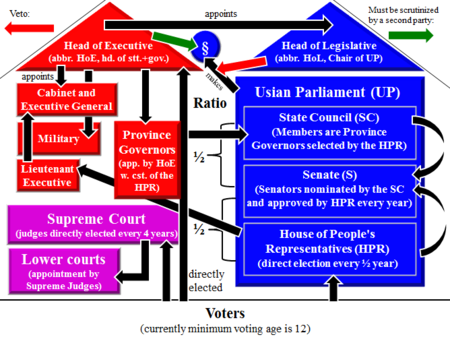
- Department of Foreign Politics (DFP)
- Department of the Interior (DI)
- Department of Finance and Economy (DFE)
- Department of Health and Human Rights (DHHR)
- Department of Education and Research (DER)
- Department of Energy and Water (DEW)
- Environmental Agency (EA)
- Agriculture Agency (AA)
- Immigration and Registration Agency (IRA)
- Travel and Emigration Agency (TEA)
- Usian Intelligence Agency (UIA)
- National Investigation Agency (NIA)
- Military Services (MS)
- Emergency Services (ES)
- Bureau of Infrastructure and Housing (BIH)
- Bureau of Transportation (BT)[7]
Demographics
Demographics and statistics relating to Usi are released periodically by the National Statistics Office, a sub-department of the Department of the Interior.
The diagrams indicate that virtually all citizens of the Usian Republic are either minors (between 7 and 18 years of age) or senior citizens (between 65 and 78), which may pose danger of a sudden drop in population in about 20 years, and then a sudden increase in working population around the same time. They also show that the majority of the population (64%) is male. The population of the Usian Republic saw a great and sharp rise in its early phase. Currently, however, growth is all but stagnant.
-
Population by age -
Population by gender -
Early Usian population boom -
Citizens by religion
Law and order
Main article: Usian law See also: Usian criminal law
The government of the Usian Republic states in its constitution that it respects human rights, justice and equality.[5] The Usian Republic differentiates law into criminal, civil, and private law. Owing to its recent founding, the Usian Parliament has not yet established many basic laws; to deal with the circumstances, "the [Usian Republic] is temporarily 'borrowing' the laws of the surrounding macronations [Germany and the United States,]" as a press speaker announced on 4 September 2014.
Usian constitution
Main article: Usian Constitution
Currently, there is no real Constitution of Usi; any citizen has the right to put forward to the Parliament a constitution of their own envisioning. The most likely proposed constitution to succeed is composed of eight articles and three appendices and authored by the Gabriel N. Pelger.[6] The first article of this constitution to be written was the third, which declares Usi's sovereignty, and, if the constitution is adopted, this declaration of independence, which was written on 13 July 2014, will have been legitimate since it was penned.[3] One of the reasons given, on 25 August 2014, by the government for the constitution's lateness was the distinction between a law and regulation that needed to be elucidated. In early September of the same year, the author the aforementioned "constitutional suggestion" proposed that two of the incomplete articles and the three virtually nonexistent appendices should be added later. This version of the constitution is currently being voted on.
Police force
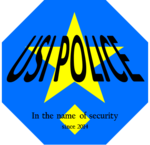
The Usian police department, part of Emergency Services, is responsible for the upholding of law and order in the entire Usian Republic by patrolling the provinces, guarding public property, and responding to emergency calls. Because of USI's scattering, the police is having a hard time adequately carrying out the aforementioned duties. All investigation is the responsibility of the National Investigation Agency (NIA). The police is not arranged in a completely hierarchical way so as to avoid corruption. The highest rank in the police is Civil Police General, of which there is more than one. The patrol police is a separate branch of the police, the highest rank there being the Patrol General. It has been suggested, in accordance with the idea to install gondola lifts as a ground transportation system instead of roads, that patrol robots be installed to act as a mobile CCTV system.
The military police is entirely separate from Emergency Services.
Foreign relations
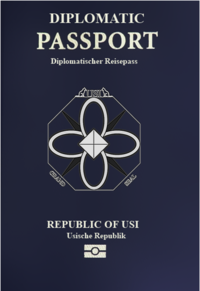
Usi also fulfills the last of the legal requirements to be recognized by international law set in many nations by the Montevideo Convention in 1933: The "capacity to enter into relations with the other states".[1] The Usian Republic is on general principle friendly towards all nations; also to micronations of lesser seriousness does Usi not deny relations. The Department of Foreign Politics (DFP) is responsible for diplomatic correspondence.
Recognized; no relations
 All member states of the United Nations - (since 13 July 2014)
All member states of the United Nations - (since 13 July 2014) Republic of Kosovo - (since 24 August 2014)
Republic of Kosovo - (since 24 August 2014) Republic of China (Taiwan) - (since 24 August 2014)
Republic of China (Taiwan) - (since 24 August 2014) Vatican City - (since 24 August 2014)
Vatican City - (since 24 August 2014)- Unofficially most other micronations, though not those territorial claims of theirs that overlap USI's claims.
 Principality of Sealand - (officially since 8 October 2014)
Principality of Sealand - (officially since 8 October 2014)
Recognized; formal relations
Other micronations
Before attempting to enter diplomatic correspondence with macronations, the Republic is extending political friendship towards other micronations.[1] This is in accordance with the DFP's policy to become widely recognized in a smaller circle before attempting to become involved with the wider world.
| Name | First correspondence | Treaties/Alliances |
|---|---|---|
| 01.09.2014 | Formerly IMA, now Castello di Valle Treaty | |
| 25.10.2014 | Informal alliance | |
| 11.12.2014 | Mutual recognition treaty | |
| 15.12.2014 | None so far | |
| 18.12.2014 | Mutual recognition treaty | |
| 05.01.2015 | None so far | |
| 08.02.2015 | Treaty of mutual recognition and friendship | |
| Number: 7 | Total: 4 |
Recognized; informal relations
 Republic of Molossia
Republic of Molossia- Republic of Covanellis
 Kingdom of Trebia
Kingdom of Trebia Republic of Bromenia (disbanded 13 June 2015)
Republic of Bromenia (disbanded 13 June 2015)
Expressly not recognized
The Usian Republic does not recognize 'conworlding' micronations. It recognizes only terrestrial claims. Also, if any claims conflict with Usian claims, those claims are also not recognized.
Organization memberships
 Organization of United Emerging States (officially since 24 September 2014), merged into the Nollandish Confederacy
Organization of United Emerging States (officially since 24 September 2014), merged into the Nollandish Confederacy Grand Unified Micronational 19 January 2015 - 14 June 2015 (organization disbanded)
Grand Unified Micronational 19 January 2015 - 14 June 2015 (organization disbanded) Union Against Micronational War 12 July 2015
Union Against Micronational War 12 July 2015
Economy and finance
All economy is monitored by the Finance Department and the First Nation Reserve and Mint Bank of the Usian Republic (informally the Bank of Usi). The monetary units are the Euro, U.S. dollars and Usi Trust Bonds (UTBs), the latter of which can be used virtually only as payment among citizens.[7] The Usian Republic plans to establish diplomatic relations and possibly trade with other nations, especially other micronations.
Taxes
Until the Usian Republic is widely recognized as an independent nation, citizens will continue paying taxes to their respective macronations, though three individuals are, as of 1 November 2024, voluntarily paying taxes. Income taxation is strongly progressive. There is, however, sales tax on items bought in the Usian Republic, that must be included in the price on the product's label: 8% for indispensable nutrients such as bottled water (only in recyclable bottles), vegetables, native fruits, non-desert whole-grain products such as bread and noodles, among other things; 19% on most other foods and beverages, but a much higher percentage on alcoholic potables. Other specification are to be released in a series of tax laws.[8]
Budget
Because of the Usian Republic's unusual situation concerning taxes (see above), the governmental budget differs slightly from that of most nations. It is quite small, with only 57.47 UTBs ($130/€100) tax money annually, though about twice the amount is collected in taxes. The other half of the tax money is saved in the First National Mint and Reserve Bank of Usi for an unforeseen crisis.

2014
Because of the Republic's currently inchoate state, and the fact that it was not declared independent until July of fiscal year 2014, the 2014 budget has been virtually nonexistent. In order to quickly establish one, the Senate has granted the Department of Finance and Economy (DFE) the right to implement nearly any budget for the rest of the year. On 16 August 2014, the DFE presented a budget weighted strongly on education and research, and, because of one-time expenses, the military, which has a great need for equipment.[6][7]
2015

The 2015 budget was passed and published by the Usian Senate on 24 June 2015.
Extra-budgetal money
In the Usian Republic, extra-budgetal money is any money donated to the government after the annual budget has been officially adopted. The donator may decide which category of the government expenditures the money goes to. Every time the reserves are high, a major extra-budgetal contribution is made by the First National Mint and Reserve Bank of Usi. A non-governmental board of governors makes the decision to give saved-up tax money to the government. This year (2014), to get the economy started, it has donated 57.47 UTBs ($134).[2]
Currency
| Usian Trust Bond | |
|---|---|
| ISO 4217 | |
| Code | UTB |
| Denominations | |
| Plural | Usian Trust Bonds or Usi Trust Bonds (UTBs) |
| Banknotes | 1/2, 1, 5, 10, 20, 50, 100, 200, 500 UTBs |
| Coins | 2 UTBs |
| Demographics | |
| User(s) | |
| Issuance | |
| Central bank | Bank of Usi |
| Printer | Special Items Production Office |
| Mint | Joint Minting Services (JMS) |
| Valuation | |
| Pegged with | 1€+1$ |
Officially, the Usian Republic uses Usian Trust Bonds (UTBs) as payment, one UTB being pegged to the value of one Euro and one U.S. dollar. The pegging is due to the widespread use of those two currencies inside as well as outside USI's borders. The first series of banknotes is to be printed in January 2015; several have already been designed. There are currently only 14 Usian coins (all 2-UTB) in circulation, minted in August 2014.
-
1/2 UTB:
obverse -
1/2 UTB:
reverse -
100 UTBs:
obverse -
100 UTBs:
reverse -
500 UTBs:
obverse -
500 UTBs:
reverse
None of the current banknotes feature Usian scientists, monuments or natural parks, because there are simple not enough interesting motifs in the Republic of USI. The 200 UTB banknote of the January 2015 series has a design error; the Bank of Usi logo is distorted.
Industry and trade
The Usian Republic does not have a goods industry, but a small service injury, with one non-governmental company (Estuvo Processing Ltd.) which provides English/German translation and data processing. The company is the main exporter of the micronation. Usian citizens derive much of their money from foreign countries, and spend very little within the Usian Republic.
Military
Military Services has presented a non-violent agenda for the year 2015. However, in 2014, the Usian government constructed fortifications as part of its Military Preparedness Policy. Two fortresses, Fort Kelp and Fort Trench, were built, but the construction finished on neither; in a short press statement, MS said that their (the forts') original planning and started construction was "substantially too small for current military purposes", and that their "strategic value" had decreased because of "unexpectedly soon changes" in military locations. The government has decided to make all members of the military who are not actively engaged members of Emergency Services. Note that Military Services was separate from the National Defense Agency (NDA) until the latter changed purpose and became the National Investigation Agency (NIA). See Structure of the Usian executive branch#Military Services.
San-Marin military base
San-Marin military base is a military base for rocketry and military science. It is located on the American continent and under the direction of General John Clark.
Alpine base
Alpine base is an Usian military base that is to be established in Sacramento, California in August.
Medals, decorations and orders of Usi
Main Article: Medals, decorations, awards and orders of Usi
The Usian Republic has a complex civilian honors system, updated regularly by the Head of the Executive, who awards and often designs the honors.
Geography and climate
The capital of the Usian Republic, Usipolis (formerly Usi City), is surrounded by the German state of Baden-Württemberg. Most of its other territories are bordered on all sides by the state of Oregon in the United States of America.[9]
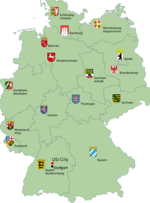
List of territories and provinces
The following is a list of provinces, consisting of land that the Usian Republic has claimed and whose owners are seceding from their respective macronation, territories, which are uninhabited and (until now) unclaimed, and outposts.
| Name and Flag | Area (est.) | Citizens | Location |
|---|---|---|---|
| 200m² (2150 ft2) | 2 | Pattonville, Baden-Württemberg, Germany | |
| 300 m2 (3200 ft2) | 2 | McMinnville, Oregon, USA | |
| 400 m2 (4300 ft2) | 3 | Pattonville, Baden-Württemberg, Germany | |
| 180 m2 (1900 ft2) | 2 | Tigard, Oregon, USA | |
| 150 m2 (1500 ft2) | 4 | Portland, Oregon, USA | |
| 100 m2 (1100 ft2) | 2 | Portland, Oregon, USA | |
| 1'610'000 km2 (621'630 mi2) | 0 | Marie-Byrd-Land, Antarctica | |
| 25 m2 (270 ft2) | 1 | Zuffenhausen, Baden-Württemberg, Germany | |
| 2'060 km2 (800 mi2) | 0 | Between Egypt and Sudan | |
| 300 m2 (3200 ft2) | 1 | Oberböhringen, Baden-Württemberg, Germany | |
| 20 m2 (215 ft2) | 0 | Villach, Kärnten, Austria | |
| Total area: 1'612'060 km2 (622'420 mi2) | Total population: 33* (2015) |
*Note: 16 citizens of the Usian Republic currently do not live on Usian territory.
Climate
As the Usian Republic is spread out over various different places, climate data is given below only for the capital, Usipolis.
| Climate data for Usipolis (near Stuttgart, Germany), for 1981–2010 (Source: DWD) | |||||||||||||
|---|---|---|---|---|---|---|---|---|---|---|---|---|---|
| Month | Jan | Feb | Mar | Apr | May | Jun | Jul | Aug | Sep | Oct | Nov | Dec | Year |
| Record high °C (°F) | 17.1 (62.8) |
21.0 (69.8) |
24.6 (76.3) |
26.8 (80.2) |
31.5 (88.7) |
35.0 (95) |
36.6 (97.9) |
37.7 (99.9) |
31.6 (88.9) |
29.7 (85.5) |
20.3 (68.5) |
16.5 (61.7) |
37.7 (99.9) |
| Average high °C (°F) | 3.7 (38.7) |
5.4 (41.7) |
9.8 (49.6) |
14.1 (57.4) |
18.6 (65.5) |
21.7 (71.1) |
24.2 (75.6) |
23.9 (75) |
19.5 (67.1) |
14.4 (57.9) |
8.1 (46.6) |
4.4 (39.9) |
14.0 (57.2) |
| Daily mean °C (°F) | 0.5 (32.9) |
1.3 (34.3) |
5.2 (41.4) |
9.0 (48.2) |
13.6 (56.5) |
16.7 (62.1) |
18.8 (65.8) |
18.3 (64.9) |
14.1 (57.4) |
9.6 (49.3) |
4.4 (39.9) |
1.4 (34.5) |
9.4 (48.9) |
| Average low °C (°F) | -2.9 (26.8) |
-2.5 (27.5) |
0.8 (33.4) |
3.8 (38.8) |
8.2 (46.8) |
11.3 (52.3) |
13.3 (55.9) |
12.9 (55.2) |
9.2 (48.6) |
5.4 (41.7) |
1.0 (33.8) |
-1.6 (29.1) |
4.9 (40.8) |
| Record low °C (°F) | -25.5 (-13.9) |
-20.3 (-4.5) |
-18.6 (-1.5) |
-6.3 (20.7) |
-1.9 (28.6) |
3.3 (37.9) |
5.5 (41.9) |
3.8 (38.8) |
0.2 (32.4) |
-6.3 (20.7) |
-14.9 (5.2) |
-18.5 (-1.3) |
−25.5 (−13.9) |
| Average Precipitation mm (inches) | 41.2 (1.622) |
36.5 (1.437) |
47.6 (1.874) |
49.6 (1.953) |
85.7 (3.374) |
86.8 (3.417) |
86.1 (3.39) |
69.1 (2.72) |
57.1 (2.248) |
58.8 (2.315) |
49.8 (1.961) |
50.4 (1.984) |
718.7 (28.295) |
| Sunshine hours | 79.8 | 96.4 | 137.9 | 177.0 | 216.5 | 216.8 | 232.4 | 224.1 | 169.4 | 122.6 | 74.1 | 60.4 | 1,807.2 |
| Source: Data derived from Deutscher Wetterdienst. Note: sunshine hours are from 1990-2012. | |||||||||||||

Transportation
Due to the lack of need to commute by vehicle in the Usian Republic (its inhabited claims being entirely comprised of very small enclaves), there never were, nor are there now, plans in the foreseeable future to introduce a system of roads and the like. The Environment Agency (EA) has been urging the Bureau of Transportation (BT), should the need and budget for a ground transportation system ever arise, that they find an alternative to motor vehicles. To this end, ideas have been submitted to the BT ranging from installing a system of gondola lifts to underground roads, the latter especially for trucks.
Culture
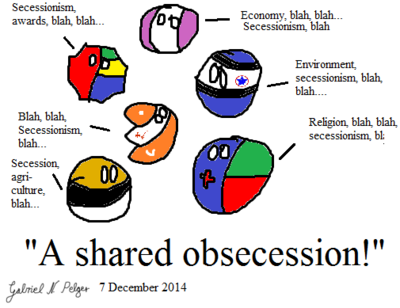

While Usian culture is heavily influenced by American, and, depending on the province, also German tradition, Usians have developed a number of unique ones.
Holidays
The different provinces of the Usian Republic set their holidays to fit those of the surrounding macronations, as most Usians are employed outside the Usian Republic. Two exceptions are the nation-wide Secession Day (13 July, the anniversary of the Usian Republic's declaration of its independence, in 2014) and Mourning Day (28 June, anniversary of the death (2014) of the national mascot, Gina I, a member of the species of the domestic cat).
Comics
There are several domestically well-known authors of various comics. On 7 December 2014, the first MicroBall comic by an Usian comic artist was published, and was well received.[10]
Music
Usians are almost universally listeners of classical music.
National symbols
The ceremonial duty of choosing national symbols is bestowed on the Head of Executive.
The Usian flag is an exception: its design is entrenched in the constitution. The Usian Republic's flag is one of the few that is proportioned in the ratio 1:2. Per the constitution, the left half of the Usian flag is red. The bottom half of the right half is colored Usian flag blue ( RGB 49, 15, 253). The half that is left over is horizontally divided into a yellow and a green area; the yellow half is slightly larger than the green half, though no exact proportion is given.
USI possesses an official Grand Seal: It has a regular octagonal shape. The octagon has above it the word "USI" in black, capital letters and the font Times New Roman, opposed on each side by a simple outline of a sitting representative of the national animal, the domestic cat. Floating slightly distanced from the two lower angled sides of the regular octagon are the words "GRAND" and "SEAL", mind case sensitivity, in the same font and color. The "interior" of the octagon is colored red. In the center, there is a simple diamond design, tilted so that the rhombus's sides are parallel to the angled sides of the octagon. The central shape's being a diamond is portrayed by two crossing lines running from the top tip to the lower tip of the rhombus. Emanating from the middle of each of the four sides of the rhombus are shapes bearing a resemblance to the figure zero. The ones running up and down are colored yellow or gold, the ones running from right to left are colored platinum or silver.
The current national anthem is an approximately 37-second long excerpt from The Nutcracker (Act Grandfather Dance) by Pyotr I. Tchaikovsky. It was chosen for its "grand and respect-commanding sound" and will be replaced eventually, "when something better suited is found."[11]
Press and media
The national press and media are regulated by the Agency of Press, Media and Computing (AMPC). The press and media have some legal limitations enforced by the Agency of Media, Press and Computing. They mainly concern censorship of obscenity and personal attacks on individuals (see Constitution of Usi). The government attempts to "ensure free speech as well as possible", as the head of the AMPC states.
See also
- Usian Parliament
- Usian Supreme Court
- Structure of the Usian executive branch
- Head of Executive
- Usian law
- Usian criminal law
- List of Usian medals, decorations, awards and orders
External links
Sources
- ↑ 1.0 1.1 1.2 1.3 1.4 1.5 "Official news website of the Usian government", Website of the government of the Republic of USI, [1], accessed 19 February 2015
- ↑ 2.0 2.1 2.2 2.3 "Official website of the Usian Republic", Website of the government of the Usian Republic, [2], accessed 24 August 2014
- ↑ 3.0 3.1 3.2 3.3 3.4 "The Government", Website of the government of the Usian Republic, [3], accessed 24 August 2014
- ↑ "Apply for citizenship", Website of the government of the Usian Republic, [4], accessed 24 August 2014
- ↑ 5.0 5.1 "Constitution", Website of the government of the Usian Republic, [5], accessed 25 August 2014
- ↑ 6.0 6.1 6.2 "Republic of USI: The Parliament", Website of the government of the Republic of USI, [6], accessed 25 August 2014
- ↑ 7.0 7.1 7.2 "Executive departments", Website of the government of the Republic of USI, [7], accessed 25 August 2014
- ↑ "Taxation", Website of the government of the Usian Republic, [8], accessed 25 August 2014
- ↑ "The territory", Website of the government of the Republic of USI
- ↑ First-hand information, [9], accessed 9 December 2014
- ↑ "National symbols", Website of the government of the Usian Republic, [10], accessed 9 December 2014
- Inactive micronations
- Usi
- Republics
- Secessionist micronations
- Secular micronations
- European micronations
- Micronations in the United States
- Micronations established in 2014
- Micronations claiming Bir Tawil
- Democracies
- Former Grand Unified Micronational member states
- Micronations in North America
- Micronations in Oregon

